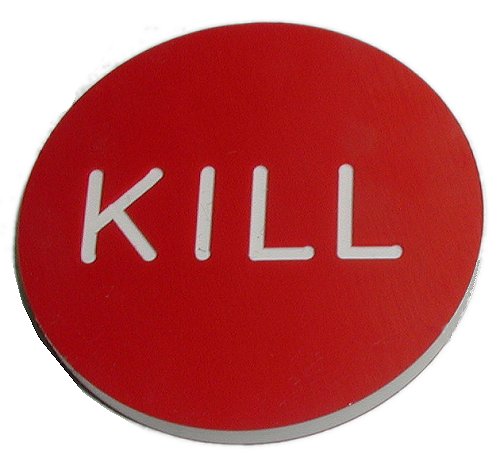 Why right now? Why are these isolated extremists pulling their triggers? What are the factors that are pushing the "kill" button at this moment in time?
The Los Angeles Times states the obvious in one of those editor-generated trend, trend, please let there be a trend features that -- in my experience -- drive most reporters absolutely nuts. You know you're dealing with a trend story when the phrase "experts agree" makes it into the lede. What does it mean with the reporter has to write, well, something like this?
Why right now? Why are these isolated extremists pulling their triggers? What are the factors that are pushing the "kill" button at this moment in time?
The Los Angeles Times states the obvious in one of those editor-generated trend, trend, please let there be a trend features that -- in my experience -- drive most reporters absolutely nuts. You know you're dealing with a trend story when the phrase "experts agree" makes it into the lede. What does it mean with the reporter has to write, well, something like this?
A day after an anti-Semite allegedly shot and killed a security guard at the U.S. Holocaust Memorial Museum in Washington, experts disagreed about whether it was an isolated event or the latest sign of a growing threat by domestic hate groups.
The danger appeared to come from two directions: far-right fanatics who feed on domestic conspiracy theories and Muslim extremists who oppose U.S. policies abroad. Both have launched deadly attacks in recent weeks.
On one level, this is an old thesis, one that currently sounds like "Glenn Beck equals Osama bin Laden." This particular news feature does have the good sense to flash back and add up a few numbers, which leads to the conclusion that the number of violent events of this kind were actually higher in the '80s and early '90s -- peaking, of course, with Timothy J. McVeigh's truck bomb at the federal building in Oklahoma City. Also, the number of attacks on Jews has declined.
So what has people worried? We are given these factors -- anger about nonwhite immigration, economic woes, arfuments over further restrictions on firearms and, of course, the election of the first African-American president.
This leads us to that April report from the Department of Homeland Security -- "Right-Wing Extremism: Current Economic and Political Climate Fueling Resurgence in Radicalization and Recruitment" -- that warned that "the return of military veterans facing significant challenges reintegrating into their communities could lead to the potential emergence of terrorist groups or lone wolf extremists capable of carrying out violent attacks."
Like I said, this Times story tried to connect some recent dots and ended up grasping at straws. Clearly, it's hard to know why distressed, angry people do what they do. However, I have always believed that people are full of paradoxes that can fester until they become fatal flaws. However, there are times when it is possible to make some sense out of their motivations.
To see an example of what I am talking about, read "A Time To Kill" by Jon A. Shields, published in The New Republic. While the Los Angeles Times piece was rather predictable, this other essay contains a stunning lightning flash of logic that journalists need to pursue. You must read it all, but here is the question that drives the action: "Why, when tensions over abortion seem to be at an all-time low, have we seen a spike in anti-abortion violence?"
Brace yourself. Shields has a motive that is logical, but will be hard for progressives to handle. Here's the basic idea: When many, many activists are not allowed to protest, a tiny number on the fringes will be tempted to turn to violence out of frustration.
Unlike the small sit-ins orchestrated by leftist Catholics, Operation Rescue orchestrated large clinic blockages in cities from New York to Los Angeles. The promise of this campaign -- and the influence of Operation Rescue -- actually controlled violence-prone extremists. Throughout the 1980s, for instance, there was an inverse correlation between abortion-related violence and the success of civil disobedience. As Christopher Keleher found in the DePaul Law Review, "the drop in the number of violent incidents correlated with increase in the number of nonviolent protests." The nonviolent, civil disobedience seemed to control violence-prone radicals by providing them with an outlet for their pro-life zeal.
But this institutional restraint largely disappeared when Operation Rescue imploded in 1992, partly because of the autocratic management style of its leader, Randall Terry. And perhaps more importantly, many activists simply exhausted their energy and vacation time in jail. These internal failures were greatly compounded by the passage of the Freedom of Access to Clinic Entrances Act under the Clinton administration, which made it a federal crime to participate in clinic blockades. The collapse of Operation Rescue released violent radicals from any institutional constraints, leaving them to their own darkest desires.
Thus, fringe people may have turned to violence -- once they knew that meaningful protests were no longer possible. Take away the First Amendment, in other words, and radicals may pick up guns.
After seven deaths in the 1990s, the editors of the Harvard Law Review argued that the crackdown on clinic blockades by the federal government closed one of the only remaining "safety valve[s]" for democratic dissent. The consequence, according to its editors, is that as we have "foreclosed nonviolent outlets of dissent, violence has increased." First Roe pushed activists out of electoral politics and into the streets, and then the federal crackdown on civil disobedience pushed many others off the streets as well -- into even darker corners. So while pro-life activism is declining on a broader level, the lives of abortion providers have never been more imperiled by extremists. ...
Sobering. Journalists may need to consider a wider range of options, when seeking to plug the "why?" slot in the who, what, when, where, why and how equation on these killings.
